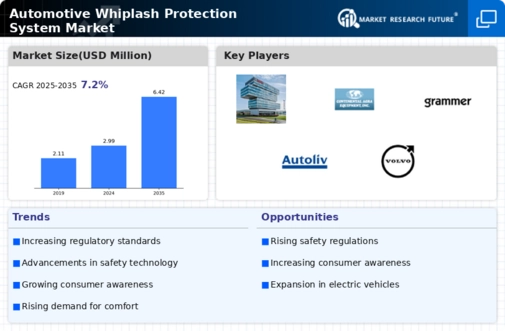Market Share
Automotive Whiplash Protection System Market Share Analysis
The automotive whiplash protection system (WPS) market has been witnessing significant developments and trends, primarily driven by a growing focus on passenger safety and advancements in automotive technology. One of the prominent trends in this market is the increasing integration of advanced safety features into vehicles. Whiplash protection systems, designed to reduce the risk of neck and head injuries during rear-end collisions, have gained traction due to their effectiveness in enhancing passenger safety. Automakers are prioritizing the inclusion of WPS as part of their overall safety suite, recognizing the importance of mitigating the impact of rear-end collisions on occupants.
Moreover, there is a heightened emphasis on regulations and safety standards related to automotive safety systems globally. Government regulations mandating the incorporation of safety features to reduce injuries in accidents are propelling the adoption of WPS across different vehicle segments. Compliance with these safety standards has become a key driver for the automotive industry, prompting manufacturers to invest in and integrate effective whiplash protection systems into their vehicles.
Additionally, technological advancements play a crucial role in shaping the automotive WPS market. Innovations in sensor technology, seat design, and active safety systems have enabled the development of more sophisticated and responsive whiplash protection systems. These advancements allow WPS to detect impending collisions more accurately and deploy safety measures swiftly, thereby reducing the risk of whiplash injuries significantly. Automakers are continuously improving WPS by integrating smarter sensors and adaptive features to enhance their effectiveness and reliability.
Furthermore, consumer awareness and demand for enhanced safety features in vehicles are driving the growth of the automotive WPS market. As consumers become more informed about the importance of safety systems in automobiles, there is a growing preference for vehicles equipped with advanced safety technologies, including effective whiplash protection systems. This increased demand is compelling automakers to make WPS a standard feature in many vehicle models, not just in high-end cars but also in mass-market vehicles.
Moreover, the integration of WPS with other advanced safety systems, such as active headrests and pre-crash systems, is emerging as a significant trend in the automotive industry. By integrating these systems, automakers aim to create a comprehensive safety network within vehicles that can anticipate collisions, adjust seating positions, and activate protective measures in milliseconds. This holistic approach to vehicle safety underscores the importance of WPS as a vital component of a larger safety ecosystem.
The automotive whiplash protection system market is witnessing steady growth and innovation, fueled by a combination of regulatory requirements, technological advancements, consumer awareness, and industry initiatives. The focus on passenger safety and the recognition of WPS as an effective means to reduce the risk of whiplash injuries have positioned it as a critical safety feature in modern vehicles. As automotive manufacturers continue to prioritize safety and invest in cutting-edge technologies, the automotive WPS market is expected to evolve further, offering more advanced and effective protection for vehicle occupants.








Leave a Comment